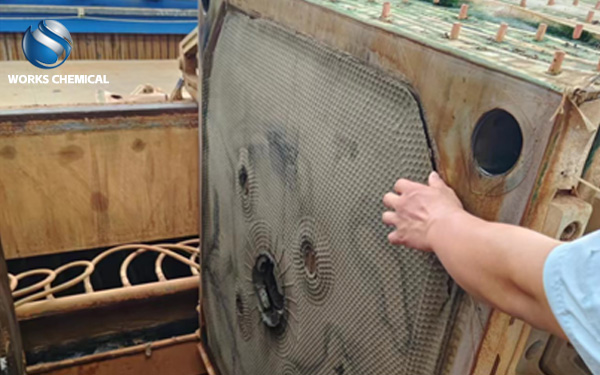
When the mud produced by the plate and frame filter press is very sticky, wet and watery, how should we solve it? Today, a technical engineer from Works Chemical will explain how the use of sludge conditioner can solve the problem of sticky and wet sludge from the plate and frame machine.

One. Problem analysis
1. High sludge viscosity: During the filtration process of the plate and frame filter press, due to the friction between the filter cloth and the filter plate, the solid particles in the sludge will gradually gather into larger clumps, resulting in increased sludge viscosity.
2. Large sludge humidity: In the filtration process of the plate and frame filter press, due to the fact that the water can not be completely filtered out, the water content in the sludge is high, resulting in large sludge humidity.
3. Poor sludge fluidity: In the filtration process of the plate and frame filter press, due to the influence of high sludge viscosity, high humidity and other factors, the fluidity of the sludge is poor, which is not conducive to the subsequent precipitation, dehydration and other treatment processes.
Second, the solution - sludge conditioner
Sludge conditioner is a chemical specially used to improve the properties of sludge, which can effectively reduce the viscosity of sludge, adjust humidity, improve fluidity, etc. The use of sludge conditioner can effectively solve the problem that the mud pressed by the plate and frame filter press is very sticky, wet and thin.
1. Reduce sludge viscosity: The surfactant component in the sludge conditioner can destroy the colloidal structure in the sludge, so that it loses its adhesion, thereby reducing the viscosity of the sludge. At the same time, the surfactant can also promote the accumulation of solid particles in the sludge, which is conducive to the later press filtration process.
2. Adjust the sludge humidity: the absorbent resin in the sludge conditioner can absorb a large amount of water in a short time, thus effectively reducing the humidity of the sludge. The sludge after conditioning can not only meet the requirements of the subsequent treatment process, but also reduce the water carrying rate and reduce energy consumption.
3. Improve sludge fluidity: the polymer composition in the sludge conditioner can improve the mechanical properties of the sludge to a certain extent and improve its fluidity. The sludge after conditioning is not only easy to transport, store and treat, but also can improve the filtration efficiency and reduce the failure rate of equipment.
Three, the use of steps
1. According to the instructions for the use of the sludge conditioner, add the appropriate amount of the conditioner to the sludge to be treated and stir it evenly. Do not add too much to avoid affecting the subsequent processing effect.
2. The conditioned sludge is sent to the plate and frame filter press for filtration treatment. After a period of operation, the sludge treatment effect was observed. If necessary, the amount of conditioner used and the mixing time can be adjusted appropriately to achieve the best results.
3. After the filter press is completed, clean and maintain the plate and frame filter press to ensure its normal operation.
Summary: When the mud produced by the plate and frame filter press is very viscous, wet and thin, the use of sludge conditioner is an effective solution. By using the sludge conditioner, we can effectively reduce the viscosity of the sludge, adjust the humidity, improve the flow, etc., so as to ensure the smooth progress of the sewage treatment process.